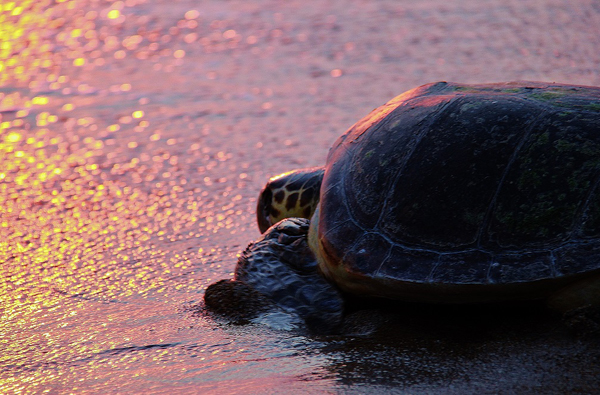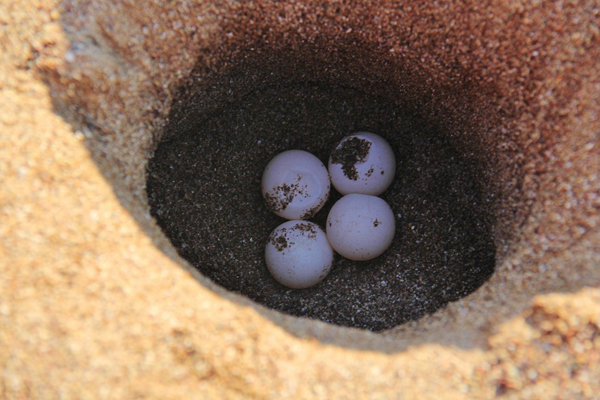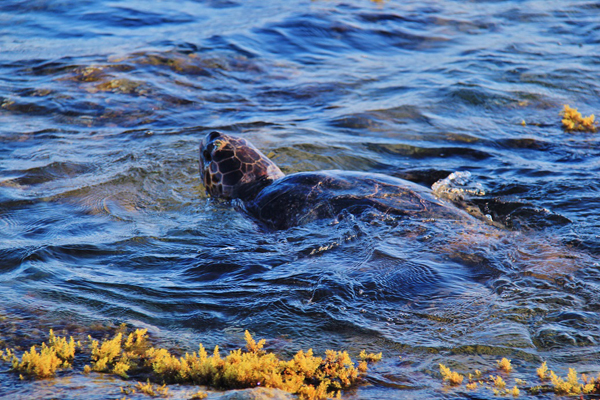Photo essay: saving loggerhead turtles in Greece
Reader contribution by Jean-Baptiste Pouchain
Among the shadows of the night, I finally spot them: fresh tracks, coming from the sea and making
their way to the obscurity of the sand dunes. Somewhere up there, a sea turtle is looking for an ideal
nesting site. Silently, I lie down on the wet ground and start crawling, all my senses on the watch, along
the crescent-like marks. I hear her before seeing her: a muffled noise of sand thrown in the air. Then,
the moonlight unveils a perfectly round carapace engaged in a pendulum-like motion. My weeks long
training to become a tagger tells me that she started digging her egg chamber. My work will start in
about ten minutes. I seize the opportunity to enjoy the greek summer’s nocturnal sky illuminated by the
shooting stars. When everything becomes silent, I carefully move forward until I’m behind the shell.
There is the loggerhead turtle, or Caretta-Caretta, distinctively brown and endowed with a large head
and a powerful beak. I observe her contractions, characterized by a steady vertical stretching of the
hind flippers, before flashing my infra-red light towards the egg chamber: a small quantity of pingpong-
like eggs is already there, while others keep falling from the reptile’s cloaca. From now on, doped
by a hormonal spurt, the turtle is unaware of the world around her. It’s time to set up the tagging
equipment: the PIT, a chip inserted in the front left flipper’s muscle via a large-gauge needle; the plastic
and the metallic tags, respectively attached between the scales of the hind left and front right flippers
with different applicators. Measurements of the carapace and a superficial statement of the animal’s
health will complete the process. If the turtle is rather old, calm and experienced, the tagging should
prove to be easy and last about twenty minutes, between the moments she covers the eggs, camouflages
the nest and goes back to sea. If she lays for the first time, it is likely that she will struggle, flap the air
with her powerful flippers, and even try to bite. But this one turtle comes as a surprise to me. While
inspecting her, my eyes are suddenly caught by a small, yellowish shape on the hind flipper: a
rectangular piece of plastic with a code. She has already been tagged. That is something I had been
expecting for a little while now, and a meaninful event as a part of ARCHELON‘s program; tags
allowing us to follow the turtles’ migrations and study their nesting patterns. A quick glance at my
logbook: I discover that she was tagged exactly two weeks ago by one of my colleagues, on this same
sector of Kyparissia beach. Turtles can lay more than four times within the nesting season, that
stretches from mid-May to mid-August and tend to come back to the same place. But they also achieve
long migrations through the seas: turtles tagged on the neighboring island of Zakynthos have thus
emerged from the Bay of Kyparissia to nest.
That is all the beauty of these reptiles, which survived the dinosaurs and never ceased to come out
under the moon to lay their eggs on the world’s sands from then on. It is such a primeval behaviour that
the holiday-makers Dimitris and Anna Margaritoulis witnessed during a mass nesting on Zakynthos in
the summer of 1977. Their life was forever transformed, and ARCHELON, the Sea Turtle Protection
Society of Greece, was officially created in 1983. Their efforts to communicate about the loggerheads,
via articles and conferences, were the basics of turtle monitoring and protection programs in Europe,
and participated in rooting them in the greek consciousness. With financial support from WWF
International and the scientific community, they identified other nesting sites of importance through
Greece, including the bay of the Kyparissia; and initiated actions of public awareness as well as tagging
programs. The task wasn’t always easy, and Zakynthos, historically the heart of the organization and the
island with the biggest nests density, faced the storm before achieving its goal: the establishment of a
marine national park in 1999. Volunteers, the main workforce of ARCHELON, were subjected to
violence from the locals and tensions culminated with a bomb exploding in the premises of the
organization, often considered by many land owners as a threat to their activities. Today, Zakynthos is
back to more friendly feelings, but the Peloponnesus has come to face similar issues. And I just need to
walk back to ARCHELON’s van at the end of my tagging’s night to be reminded of it. Our four tyres
have been properly slashed, the engine is unroadworthy. Panick, anger. We know perfectly well who is
behind it, because they are the same people that, day after day since the beginning of this 2013 season,
have been trying to prevent us from doing our work in the name of real estate and money. Welcome to
ARCHELON, the volunteering program that can offer within a single night the most exciting of
wildlife encounters, as well as the premises of an ecological war.
It took me little time to learn that the organization had alone dared to stand up against illegal
development. I had just arrived at its base camp, on the Western coast of Peloponnesus, for a two
months volunteering during the nesting and hatching seasons. Before being trained to be a tagger, I had
followed other volunteers from different countries in their main task: morning surveys, carried out by
groups of three to five people over 10 km of sandy beach to look for and protect turtle nests. We had to
spot all the tracks from the previous night, to determine whether they led to an actual nest, and to
protect it from predators and human disturbances with metallic grids and bamboos. My first impression
had been that of a preserved environment, barely known of the tourists. The beautiful scenery and the
excitement of a treasure hunt-like volunteering were only matched by the physically demanding work
and the unbearable heat. Then, I had noticed that we were being followed by a rather unpleasantlooking
man with a dog. I had been told he was an observer, nicknamed “Napoleon”. A local real-estate
company had hired him, as well as others, to collect informations about our
work and try to prove that ARCHELON wasn’t carrying any serious study out, and was even falsifying
field datas, for instance by dividing the nests in order to increase their total number. The firm was then
hoping to crush the main obstacle to its goal: the illegal building of 50 luxurious villas on one of the
main nesting site of loggerhead turtles, protected by the Natura 2000 networking european program.
Development had already caused major damages to the bay’s ecosystem when its caterpillars had
wiped out parts of the pine forest and sand dunes habitat bordering the beach, in order to build five
illegal roads. The survival of the loggerheads, classified “endangered” on the IUCN Red List, had been
more compromised and some of the coast’s inhabitants had then dared to demonstrate. Nowadays, if the
proposed plan has been stopped by ministerial decision, the firm’s methods have switched to the
guerilla warfare; vandalizing our van or sending intrusive, and sometimes aggressive, observers being
only a few of its multiple aspects. That is how, from appalling discoveries to reactive measures, the
2013 volunteering season within ARCHELON is torn between joy and bitterness. One day, the public’s
awareness raised through conferences and slide-shows fills us with satisfaction; the day after, we
experience frustration upon discovering that turtle tracks have been scrubbed and nests’ protections,
stolent during the night. The morning surveys’ excitement alternates with the fear to be threatened, or
even bullied, while tagging in the dark. The locals, once standing for their rights, refuse to take part
nowadays. The code of silence prevails, and those who push turtles away with their lights seem to have
been granted impunity; forcing ARCHELON to set up night patrols on the beach. For the first time
since 1989, we were obliged to shut our seasonal information kiosque down. This is how the
organization has become a textbook case of today’s world’s conservation issues, when development and
money clash with nature and preservation.
Like every turtle species in the world, anthropogenic threats to the loggerheads are the main cause of
their decreasing number: bycatches from fisheries; trawling, that drowns the air-needing reptiles in
giant nets; plastic bags, which are confused by turtles with jellyfish; or the illegal wildlife trade, mostly
for the asian market. In the bay of Kyparissia, and especially next to the small town of Kalo Nero,
turtles are subjected to land disturbances, such as tourists inconsiderately encouraged by a hotel owner
to look for them at night; or beach bars with flashing lights and invading chairs. Panagiota Theodorou,
project coordinator in the Peloponnesus, denounces this illegal development by a contradiction: “these
sites are the property of all of us, that will benefit us on the long-term much more than a short-lived
building activity. It’s like slaughtering the goose that lays the golden eggs…” Not to mention the turtles’
ecological importance, a key-species to the environmental balance. Not only do they regulate other
marine species such as jellyfish (and, a fortiori, plankton and fish), but the nutrients coming from the
eggs laid in the sand contribute to the stabilisation of the dune system and minimize the beach erosion.
Hence the essential mission of public awareness to which ARCHELON is commited since the
beginning, that prides itself to inform over 35 000 people annually, in Zakynthos only. Unfortunately, the
project is getting no help from a Greek state in dereliction, tainted by corruption and deprived of
satisfying, enforced environmental laws. Some stubborn Greek people are inclined to every extremism,
illegal development being one of the worst. “The environment is always the first thing being inflicted,
regrets Theodorou. But the economic crisis and unemployment that exist in our country should not be
an excuse for actions that will lead to reckless destruction of habitats and areas of high ecological
value. The State will have to make up for the damages to Kyparissia’s bay.” However, as of today, an
efficient turtle conservation system has yet to be implemented: they still suffer great disturbances
throughout Greece. Because of this violation of articles 6 and 12 of the Habitats Directive 92/43/CEE;
the country, as part the of the Europe-wide Natura 2000 network of nature protection areas, received a
reasoned opinion from the European Comission in October 2012. Since then, nothing.
When the nesting season comes to an end, it is replaced by the hatchling season, after about 55 days
of incubation. Despite all the issues that ARCHELON had to face this year, we protected the highest
number of nests ever recorded: over 1500, twice as much as the previous year. For the first time,
Kyparissia has become the most important nesting site for loggerhead turtles in Europe, before
Zakynthos. The chaotic profusion of hatchlings rushing to the sea offers a touching contrast to the
feeble arguments of ARCHELON’s enemies. “We are now witnessing the consequences of the great
work carried out by the organization for 30 years, explains Celine Campana, veterinary-nurse and
returning volunteer. Our volunteering program made this increase in nests number possible, thanks to
worldly people who come to experience something new, and then come back because it’s the best thing
they have ever done. We train them, give them responsibilities, and they are rewarded by close
encounters with sea turtles.” If the 2013 season is a conservation success, the organization’s protocols
can be improved, stresses Theresa Stewart, ecologist and monitoring leader at Kyparissia camp. “I
believe that a more holistic approach to habitat management is required in this area. A habitat
management plan should incorporate the entire coastal ecosystem, which includes the beach, sand
dunes and coastal pine forest, which should be protected as a whole and not as individual habitats as
the degradation of one will ultimately impact another.” The long-term goal for Kyparissia is the same
as Zakynthos: the establishment of a protected marine national park. In hope that today’s volunteers
will be able to come back in 15 years without witnessing the same damages inflicted, for instance, to
Crete: its Rethymno beach, once roamed by turtles, is nowadays mostly filled with beach chairs.
According to Stewart, a middle-ground is possible: “ARCHELON has a motto which is “We can all
live together”. The thought behind this is that humans can use the beach in the day time and we can
then remove all of the beach furniture when the sun sets and leave the beach at night only for turtles.
Appropriately designed mitigation schemes can work to incorporate measures that minimize impact to
the habitats and species present and include habitat creation.” Therefore, in the future, men will have to
find a way to come to terms with loggerheads. “I never lose my faith in people and their potential,
concludes Theodorou. Kyparissia needs a local government with a vision, good promotion strategies
and a strong will for work in order to develop the area in a sustainable way.”
I remember the night of August 6th. I had just tagged a turtle whose nest was right next to one of
Hotel Irida’s beach chair, in Kalo Nero. The owner was notoriously bad-tempered, and I knew this nest
would be the source of issues for the morning team. The next day, while my colleagues were trying to
protect it, he and his wife had rushed towards them and started pulling violently the bamboo sticks out
of the sand, in order to dig and make sure it was an actual nest. Volunteers had defended themselves,
locals had joined the melee, and the police had intervened. Suddenly, 18 hatchlings had come out of a
neighboring nest together and, covered in sand, had run to the sea under the guard of volunteers and
marvelled tourists. Those turtles that would perhaps come back to nest at this very same place had just
put an end to the drama with a glimmer of hope.
Note: The information in this post is the opinion of a guest contributor. Any views expressed are those of the author and do not necessarily reflect the views or endorsement of mongabay.











